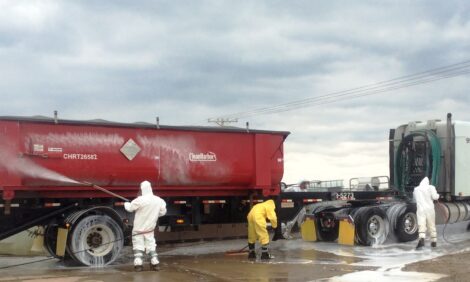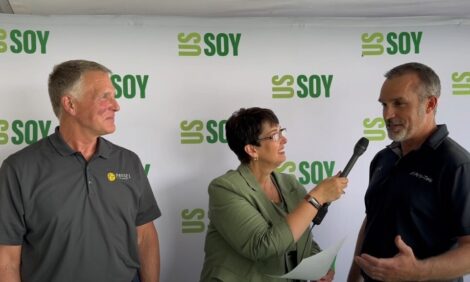



Assessing the risk of HPAI to swine and humans
Learn more about highly pathogenic avian influenza and it's impact on domestic livestockFor the first time in the US, highly pathogenic avian influenza (HPAI) has been identified in domestic livestock including goats and dairy cattle. To understand the threat HPAI poses to domestic livestock species and to inform producers on actions that can be taken to reduce the risk of infection on-farm, the US-based Swine Health Information Center (SHIC) in collaboration with the American Association of Swine Veterinarians (AASV) recently hosted a webinar on influenza A viruses. The recent detection and confirmation of HPAI in domestic livestock by USDA has raised questions regarding the emerging threat and potential risks for swine herds.
Editor’s note: Webinar content has been edited for length and clarity. To watch the full webinar, please visit https://iastate.app.box.com/s/o6dhclv5irvspcbj5q8p21ujr4a9ei29.
Researchers at USDA are conducting experiments in swine to assess the risk highly pathogenic avian influenza (HPAI) poses to swine. HPAI is a virus and needs a cell to replicate. Because it has a segmented genome, this means if two or more different viruses infect a single cell, they can exchange these gene segments. A virus that is more adept at that host may pop out of that cell and be more able to transmit within the population. At a recent webinar hosted by the Swine Health Information Center and the American Association of Swine Veterinarians, USDA ARS Research Veterinary Medical Officer Dr. Bailey Arruda looks at the HPAI situation in swine.

According to Arruda, HPAI refers specifically to a phenotype in poultry based on the presence of a run of basic amino acids that allows the virus to replicate in organs outside the gastrointestinal tract, which include the brain, heart, spleen and pancreas. Usually low-path avian influenza can be found only in the gastrointestinal tract and upper-respiratory tract of poultry. High-path influenza can escape these sites and go systemic in these birds, which leads to high mortality in infected poultry. Not all high-path avian influenza viruses have the same phenotype within or between species. For example, ferrets are used as a model for humans. If you give one H5N1 HPAI to a ferret, it may develop encephalitis. If you give it a different but similar virus, it may not develop encephalitis.
“Unfortunately, we do not have the knowledge necessary to predict which virus or viruses pose the most risk to livestock based on sequencing,” Arruda says.
How did we get it?
HPAI was introduced multiple times into the Americas, and an early European introduction was maintained. Frequent reassortment with endemic North American LPAI led to many co-circulating genotypes of potentially different phenotypes.
According to Arruda, 28 human cases of H5N1 have been detected globally since the beginning of 2021. Of those, 13 have been caused by clade 2.3.4.4b viruses, which are used in swine models. Most cases have been mild or asymptomatic including two in the US. Around the world, there has been one fatal case and several severe enough to require hospitalization. All cases, except for a case in Chile, had exposure to infected animals.
Why evaluate these viruses in swine?
First, there has been a change in the epidemiology of HPAI. It is infecting unprecedented numbers of mammalian species. There is mammal-to-mammal spread in some instances. Additionally, 20 percent of these detections contain a mammalian adaption marker that makes it more adept at replicating in mammals. Thus, there is potential for increased risk to humans if HPAI becomes mammalian adapted. When HPAI causes disease in mammals, it is commonly severe.
In the US, HPAI has been detected among wild birds including mallard and other ducks, Canada geese, black vulture, snow geese, bald eagle and other raptors. Very few wild bird samples have shown a mammalian adaptation marker. However, like the mammals, a change in the epidemiology also is observed in this population. There is continued circulation of and disease due to the virus.
Poultry flocks continue to be infected predominantly by wild birds, rather than from poultry-site to poultry-site. More than 85 million birds have been affected. Like the wild birds, mammalian adaptation markers are rarely detected in viruses originating from poultry.
Secondly, because there have been periodic detections of low pathogenic avian influenza (LPAI) in commercial swine since 1999, it is important to evaluate risks of HPAI to commercial swine facilities.
“In swine, LPAI has been reported as a respiratory disease with varying extent of transmission,” Arruda says. “The sources of a majority of cases have been unknown. Sources for some cases were thought to be raw lake water. Further demonstrating the risk to swine and their susceptibility, we saw seroconversion to HPAI H5 of swine on a multi-species farm in Italy.”
Thirdly, swine-adapted IAV infection in the U.S. is common in commercial production. To further understand the risks to swine and human health, we need to understand what the steps are to species adaptation.
Studying species adaptation
Fortunately, multiple steps are required for adaptation. Arruda and other scientists are researching the divergent pathology and transmission among avian and mammalian isolates of highly pathogenic avian influenza A (H5N1) strains in swine. In one study, scientists selected four strains of HPAI H5N1 to evaluate in their swine transmission and pathogenesis model.
According to Arruda, these four strains were selected due to their frequency of detection. Two of the strains had a mammalian adaptation marker; these two strains originated from a raccoon and a red fox. The four strains were all field isolates and had no genetic manipulation. The study looked at 15 inoculated pigs given the virus inter-nasally. All viruses replicated in the lung in pigs. Only viruses with mammalian adaptation marker were detected in the upper respiratory tract of pigs and transmitted to limited number of contact pigs. This was a unique finding, as transmission of HPAI in pigs has not been previously observed in studies performed at USDA. The study showed detection is considerably less frequent than expected for a swine-adapted influenza A virus. Lesions or damage to lungs were found across all groups, but severity varied.
In summary, overt clinical signs were not observed. All isolates caused lesions consistent with IAV, but there were differences. The number of pigs with consistent lesions varied. There were differences in severity of lesions and antigen distribution. Only mammalian isolates had limited shedding and transmission.
Further studies are being conducted. Arruda stresses that final conclusions are pending and additional strains will be tested. Also, scientists are looking at feral swine samples in collaboration with Wildlife Services National Feral Swine Surveillance at USDA.
“The take home is that pigs are at risk from NA H5 circulating strains,” Arruda says. “Risk is higher for incursion into swine located in backyard multi-species or transitional outdoor pig farms that include poultry and/or waterfowl species. However, risk of incursion into conventional confinement swine operations in the US is likely low but awareness and precautions are critical.”






